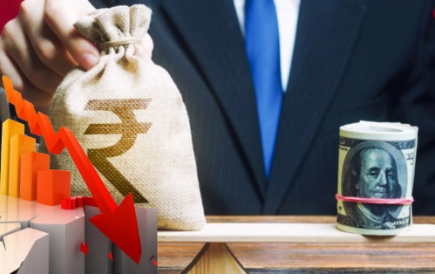
The Indian Rupee made a notable recovery in the foreign exchange market on Thursday by rising 14 paise to close at ₹86.59 per U.S. Dollar. This increase, though small in number, carries significant weight in the financial ecosystem of India. The currency had been experiencing fluctuations in recent weeks, but this improvement is a welcome development, signaling a phase of relative stability in the foreign exchange (forex) market. The strengthening of the Rupee is seen as a reflection of both global economic shifts and domestic financial resilience. As India continues to attract foreign investments and oil prices dip slightly, the Rupee finds some breathing room to recover.
What Caused the Rupee to Strengthen?
One of the main reasons behind this gain is the slight weakness in the U.S. Dollar in the global market. The Dollar Index, which measures the value of the U.S. Dollar against six major world currencies, showed a downward trend after the U.S. Federal Reserve indicated a pause in interest rate hikes. This decision caused a drop in demand for the Dollar, which, in turn, allowed emerging market currencies like the Rupee to appreciate.
Apart from the Dollar’s performance, there has also been a steady inflow of foreign capital into Indian equity and debt markets. Foreign Institutional Investors (FIIs) have been actively investing in Indian companies, especially in sectors like technology, banking, and energy. This positive sentiment from foreign investors has increased the demand for the Rupee, boosting its value.
Another significant factor is the decline in global crude oil prices. India imports a major portion of its crude oil needs, and the price of oil directly impacts the trade balance. With oil prices falling below $82 per barrel, the pressure on India’s import bill has eased. A lower import bill means less demand for the Dollar and more strength for the Rupee. Furthermore, India’s macroeconomic indicators, such as a stable inflation rate, increasing GDP, and rising exports in key sectors, are building investor confidence and supporting the Rupee’s recovery.
The Role of the Reserve Bank of India
The Reserve Bank of India (RBI) has also played a key role in managing currency stability. Though the central bank does not officially target a specific exchange rate, it frequently intervenes in the forex market to curb excessive volatility. By selling or buying Dollars in large volumes, the RBI ensures that the Rupee does not swing too wildly. This helps maintain trust in the Indian currency and reduces the risk for businesses and individuals dealing in foreign exchange.
In recent weeks, the RBI has likely been managing the flow of capital in and out of the economy through its forex reserves. These reserves have remained healthy, crossing $640 billion, and offer a strong cushion against sudden market shocks. The central bank’s careful handling of liquidity and interest rates is also contributing to controlled inflation and currency balance.
How This Change Impacts Importers and Exporters
A stronger Rupee is generally good news for importers. Companies that import goods like crude oil, electronics, heavy machinery, or raw materials will now spend less in Rupee terms. This helps reduce their overall costs and may even lead to lower product prices for Indian consumers. Businesses in sectors like automobile manufacturing, technology, and construction stand to benefit the most.
However, for exporters, a rising Rupee could bring some challenges. Export-oriented sectors like information technology (IT), pharmaceuticals, textiles, and gems and jewelry earn profits in U.S. Dollars and other foreign currencies. When the Rupee appreciates, these Dollar earnings convert into fewer Rupees, reducing overall profits. That said, since the gain is only 14 paise and the Rupee still remains in the ₹86 range, the impact on exports is relatively mild for now.
Travel, Education, and Overseas Spending Get Cheaper
One of the most direct benefits of a stronger Rupee is experienced by Indian travelers, students, and families with financial obligations abroad. When the Rupee gains value, it means that you get more foreign currency per Rupee. This makes it cheaper to pay for foreign tuition fees, travel expenses, international shopping, or money transfers. For those who plan to study in the U.S., U.K., or Australia, or for families supporting relatives abroad, this appreciation comes as a welcome relief.
Tourism companies and travel platforms have also reported increased inquiries and bookings as the exchange rate improves. Airline ticket prices for international routes, hotel bookings, and holiday packages in Dollar-linked countries are now more affordable, giving a boost to the travel and hospitality sector.
Effect on Stock Markets and Investments
The Indian stock market tends to respond positively to currency stability. On Thursday, both BSE Sensex and Nifty 50 indices saw upward movement as the Rupee’s appreciation lifted market sentiment. When the currency is strong, foreign investors are more likely to put money into Indian stocks and bonds. This increased flow of foreign funds supports stock prices and creates a ripple effect across the investment ecosystem.
For domestic investors, a stable Rupee also reduces the risk of losses in mutual funds and exchange-traded funds (ETFs) that invest in international markets. Investors planning to diversify their portfolios by investing abroad benefit from better exchange rates and improved returns.
Economic Indicators Driving Confidence
The Rupee’s gain also reflects confidence in India’s economic fundamentals. The country has maintained a positive growth rate, with estimates suggesting a 7%–7.4% GDP growth for FY 2025. Inflation, which had been a concern in the past, has come under control, hovering around 4.7% in May 2025. Moreover, industrial output and manufacturing data have shown steady improvement, suggesting economic resilience despite global uncertainty.
Another encouraging sign is the current account deficit, which has narrowed thanks to rising exports and reduced energy import costs. India’s services sector, especially IT and financial services, continues to generate surplus earnings that help offset merchandise trade deficits.
What Experts Are Saying About the Rupee’s Future
Financial experts and currency analysts have noted that this upward movement in the Rupee is a sign of short-term strength rather than a long-term trend. According to Anindya Banerjee, Vice President at Kotak Securities, the Rupee is gaining from positive flows but remains vulnerable to external pressures, such as U.S. inflation numbers, interest rate decisions, and global geopolitical developments.
Market analysts expect the Rupee to trade in a narrow range between ₹86.30 and ₹87.20 in the coming days. They advise caution, noting that a sudden increase in oil prices or a stronger U.S. Dollar could reverse the recent gains. Still, the present situation provides an opportunity for Indian businesses and individuals to plan ahead and make the most of favorable currency rates.
Global Risks and Opportunities
Despite the current optimism, global risks such as political conflicts in the Middle East, slow economic recovery in China, and continued inflation in Western economies could affect the Rupee. India, being a trade-linked and investment-sensitive economy, cannot remain entirely unaffected by what happens globally. However, with its strong domestic demand, stable government, and improving financial infrastructure, India remains in a relatively strong position.
Opportunities lie in increasing bilateral trade partnerships, technology exports, and domestic manufacturing, which will keep foreign exchange earnings high and support the Rupee in the long run. Government schemes like ‘Make in India’ and PLI (Production Linked Incentive) programs are encouraging international companies to invest in Indian manufacturing, which will further improve the foreign exchange situation.
The news that the Rupee rose 14 paise to close at ₹86.59 per U.S. Dollar is not just a financial headline—it’s a reflection of India’s strengthening position in the global economy. The gain might be modest, but its implications are wide-ranging. It supports imports, encourages investment, reduces foreign spending costs, and sends a positive signal to the global financial community.
While there are still many uncertainties ahead, India’s macroeconomic foundation is showing resilience. If the government and the RBI continue to maintain a balance between growth and inflation, and if foreign interest in India remains high, the Rupee could see further gains in the months ahead. For now, both businesses and citizens can take a moment to breathe easy and make smarter financial decisions backed by a more stable Rupee.


































